Learn to Build a Fence, Arbor, or Bridge to Support Your Tomatoes
Maximize your plants’ health and harvest with these beautiful and functional staking options
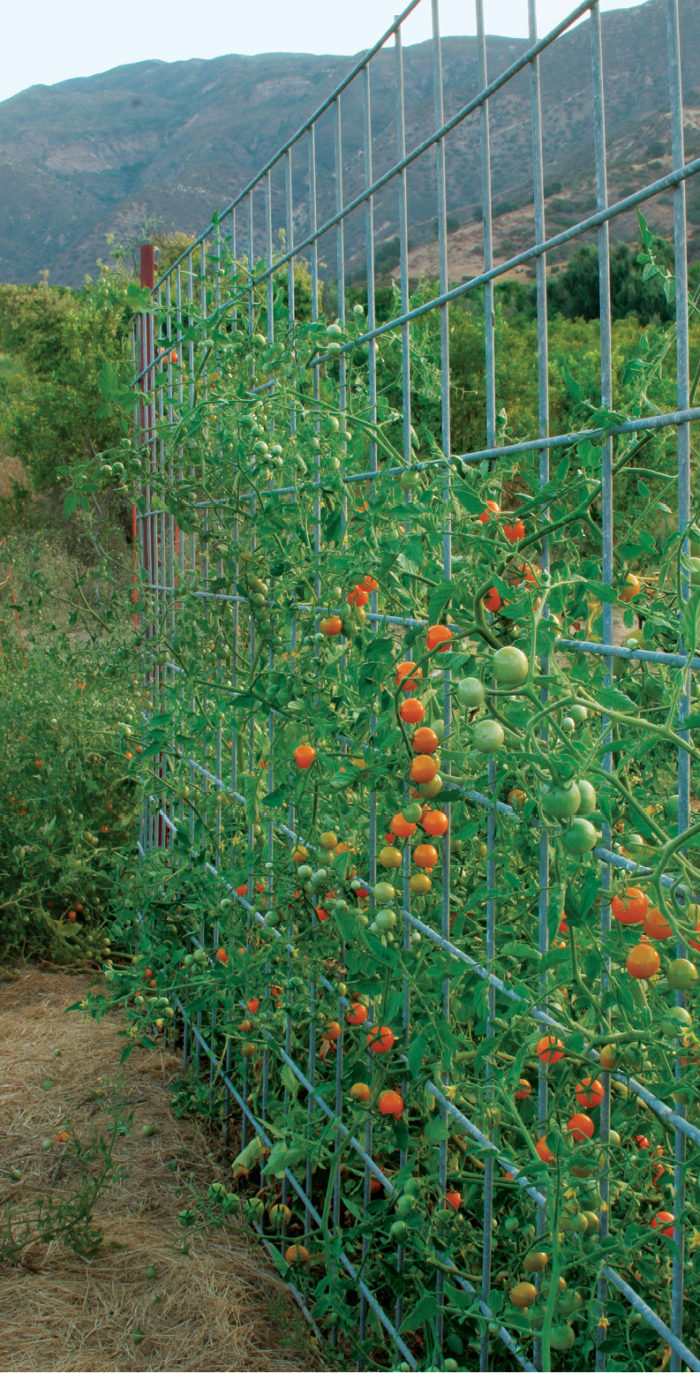
Peek over the back fence of almost any home in summer and you’ll find it: a robust tomato plant standing proudly, its leaves, stems, and fruit bulging out, around, and over the constraints of a small—and now hardly visible—metal cage. Birds migrate; we grow tomatoes—like clockwork. And whether you’re a gardener who’s an eager beginner or a seasoned pro, it can be hard to imagine that the tiny tomato seedling bought at the cusp of the growing season just might—in very short order—turn into a large and rangy behemoth that needs some assistance standing upright.
Not every tomato plant, of course, fits this description, but a large number of them do. And a lot of us find that the cages and stakes we set up as support structures often need support themselves as harvest time approaches. So why not try something a little different in your garden patch this spring? Abandon the cages that are waiting in the garage (or use them to corral your eggplants, peppers, and beans) and support your tomato seedlings in a unique and effective way, such as along a fence, up an arbor, or across a bridge. By training your tomatoes along a flat plane, you’ll get not only a garden that is more orderly but also the kind of tomato harvests every gardener longs for.
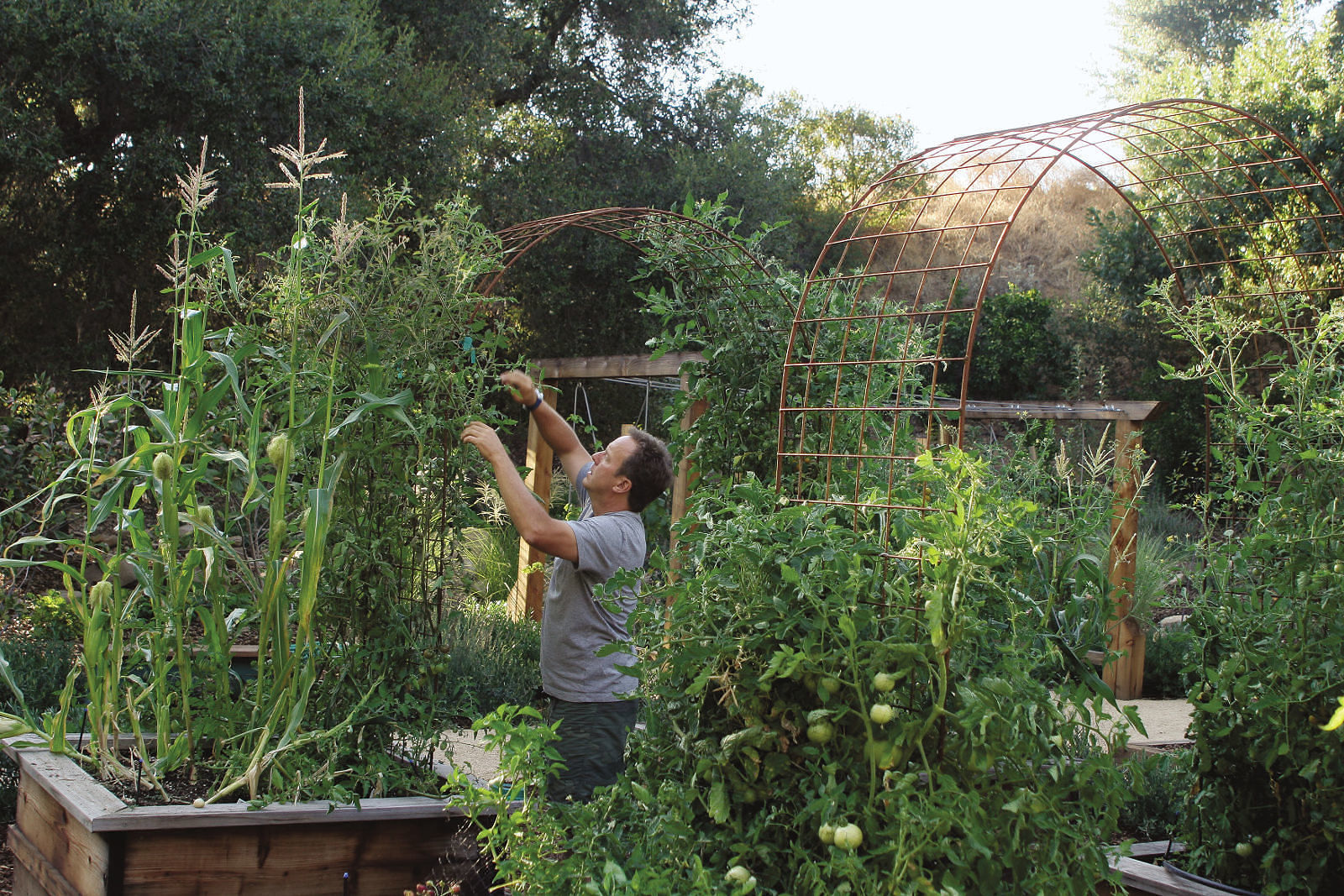
Rethink your tomato cages for better production
The most prolific tomato plants I ever saw were not a special variety, but they were grown in a special way. The tomatoes were planted at the base of 5-foot-high wire fencing, and their growth was spread out and tied gently across the span—and the branches were covered in tomatoes. I’d never seen such uniform and extraordinary production. It shouldn’t have shocked me, though, because this was just another version of espalier, a garden-design discipline that has been practiced for centuries. Strict pruning and rigid growth patterns channel the energy of the plant and generally result in remarkable production. I’d just never thought of doing it with tomatoes.
The best way to make any vegetable plant produce well is to provide the required amount of sun to every leaf and set of leaflets. Yet most conventional cages do precisely the opposite. Leaves and branches are forced together in a tight and spreading column, inevitably limiting the sun’s access to the lower portions of the plant. This is especially true for those of us who don’t pinch continually. While it works reasonably well in most seasons and it’s practical in our space-challenged home gardens, it’s not optimal.
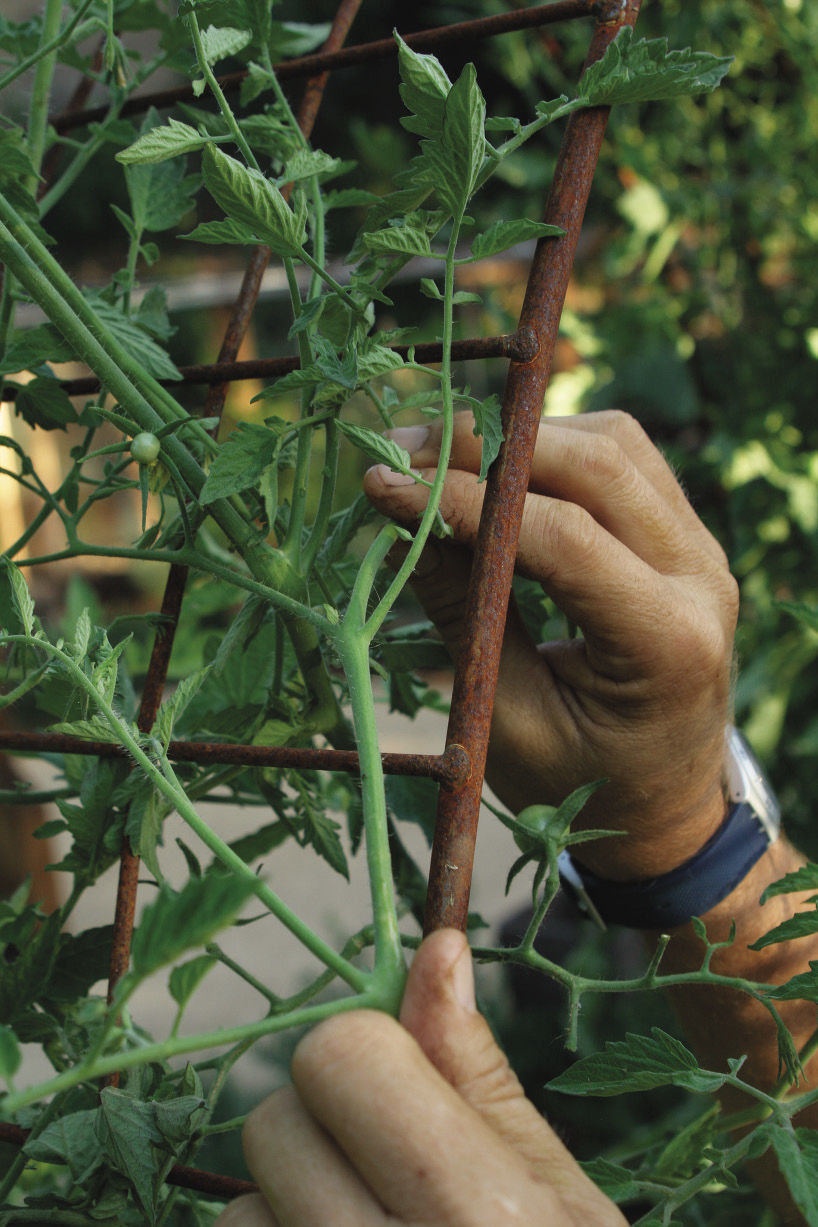
If you increase sun exposure, you’ll decrease tomato diseases
If plants are pruned or pinched aggressively and spread out along a flat plane (north/south alignment is best), almost every leaf will get full sun or at least the six to eight hours needed for maximum performance. It doesn’t matter whether you train the plants along a fence, up an arbor, or across a bridge, as long as they’re splayed out across a freestanding panel. Plants that receive the right amount of sunlight (assuming you’ve also provided a rich soil base and appropriate irrigation) will photosynthesize optimally, making for wonderfully healthy plants that generate as much fruit as they are capable of producing.
There are other advantages to growing your tomatoes along a flat plane. Huge tomato plants won’t flop all over the rest of your garden as they sometimes do, and they won’t shade other sun lovers all day. The wider spread allows for good air circulation, helping limit fungal diseases. Pests will be easier to locate and dispose of, picking is a breeze, and—on top of that—these structures are beautiful additions to your garden.
It doesn’t matter how you train your tomatoes up, it only matters that you think of a new use for those old cages and switch to a flat plane. If you do, you’ll add a bit of wow to your garden and to your summer, as well, as you—and your family, friends, neighbors, and coworkers—relish your largest tomato harvest ever.
These tomato supports have style
When it comes to propping up tomatoes, I like to choose from among three unorthodox methods. Here is how I build supports that provide both form and function.
A tomato arbor is a unique entryway option
An archway is an ideal tomato support. Plant along the bottom of the upright columns and gradually twist and tie the branches up and over the crossbeam at the top. Prune and pinch all of the branches that want to stray away from the support. Tomato arbors are a great way to make an eye-catching entrance to a garden. Wooden trellises, bamboo stakes, and lattice can all be fashioned into an arbor-support system.
My favorite varieties for this type of support: ‘Black Cherry’, ‘Black Plum’, ‘Sun Gold’
Tomato plant bridges can assist other veggies
If you use hog wire or can construct similar sturdy fencing panels, try this variation of support. Anchor the base of the sections, lean them forward for optimal sunlight exposure, and tie off to posts so that each panel rests at a 45-degree angle. Plant near the base and as the plant grows, drape it over and across the top of the angled panel. Tying may not even be needed as the plant spreads out atop the support. Pinch as necessary. Developing fruit will hang through the grid and will be shaded by leaf cover. The garden section underneath that gets wonderful filtered light throughout the day is a great space for late-winter or early-spring lettuces.
My favorite varieties for this type of support: ‘Fourth of July’, ‘Green Zebra’, ‘Jaune Flammé’
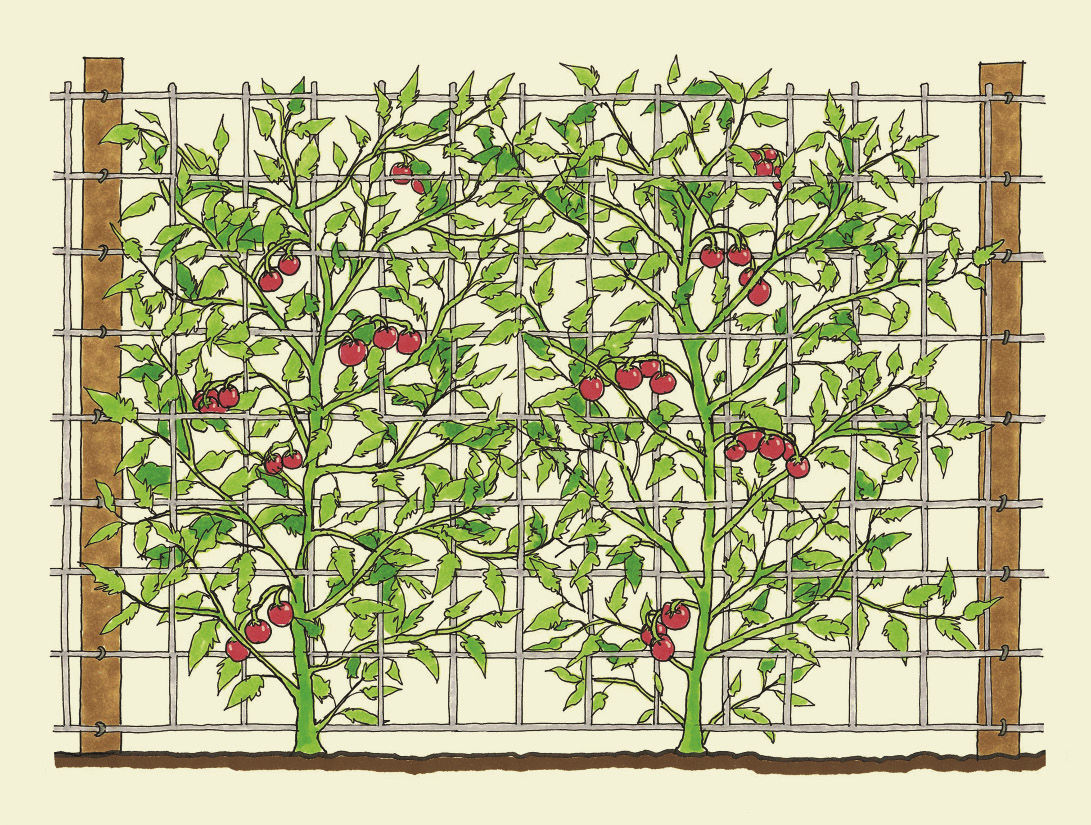
Fencing tomatoes creates a living wall
If you already happen to have a sturdy wire fence around or near your vegetable garden (or are open to building one), you can use it to support your tomatoes and create a living wall. After planting against the bottom of the fence, tie off the branches as they grow, spreading them wider and wider (or as wide as your support will allow) to give each of the leaves the maximum amount of exposure to the sun. Attach the branches with soft ties, hook-and-loop tape, or twine.
Leave some space between the attached branches, and pinch or cut off any that won’t fit within the plane. (Gardeners in superhot areas may want to pinch judiciously as a bit more cover will help protect your fruit from sunscald in the hottest part of the growing season.) If the plant reaches the top of the support, you may be forced to cut the tip or you could allow the top branch to lean and run along the top line of the fence panel.
My favorite varieties for this type of support: ‘Brandy Boy’, ‘Gold Medal’, ‘Zapotec’
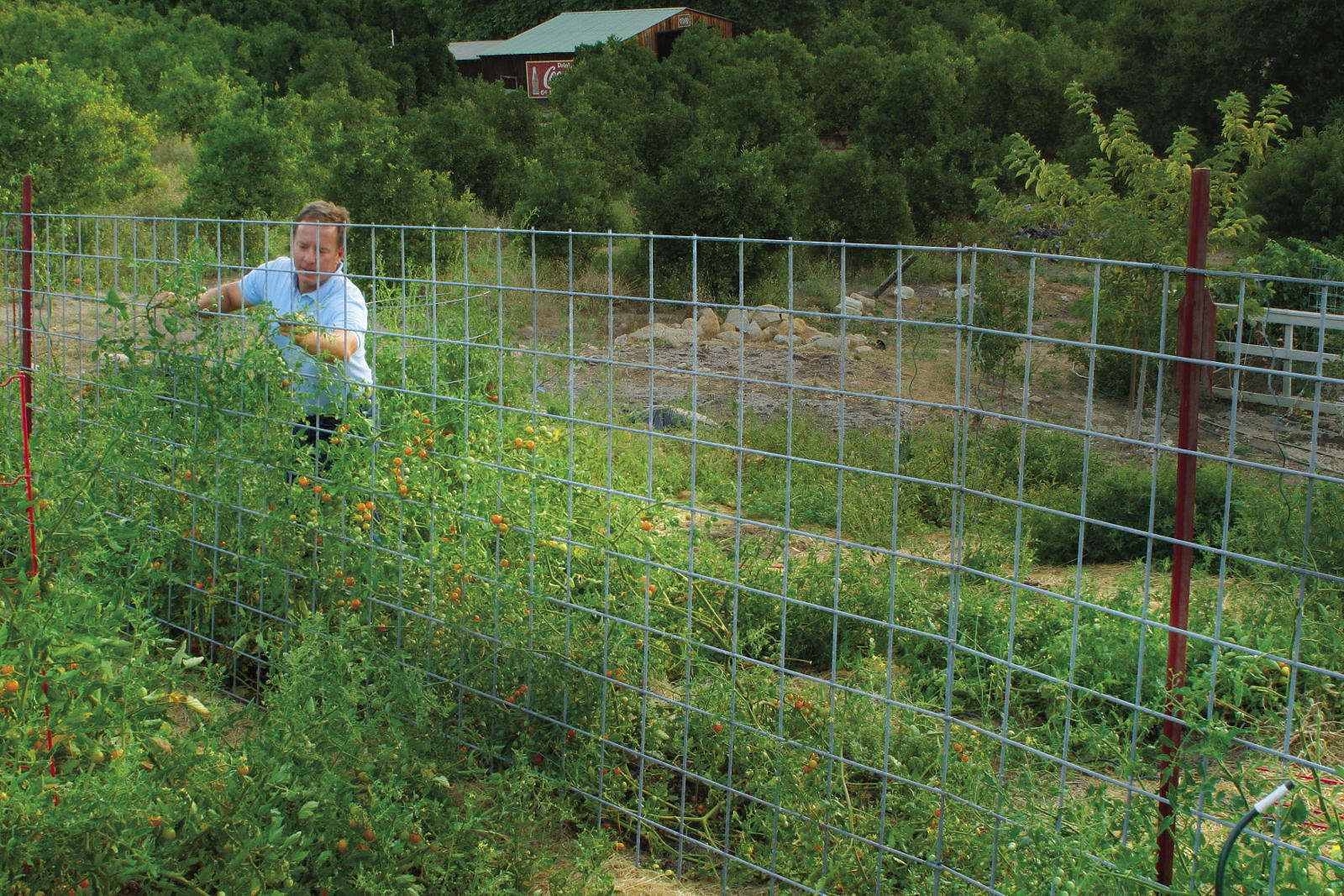
TIP: Invest in high-quality fencing material
If you don’t already have a wire fence or flat plane for support in your space, it’s easy to put together a worthy one:
• Concrete reinforcing wire supported by sturdy posts works well and will adequately brace a hefty tomato plant. Spread it out in a line, or wind it through your garden.
• Heavy galvanized animal-fencing panels (sold as hog wire or horse-corral panels) can be found at most feed stores. Incredibly sturdy—though a bit unwieldy—they are great support candidates. In this case, you may not have to tie the plants at all if the branches are woven in and out of the metal grid.
Scott Daigre is a garden designer in Southern California and producer of Tomatomania!, the world’s largest tomato-seedling sale.
Photos: Steve Aitken. Illustrations: Martha Garstang Hill








Comments
Log in or create an account to post a comment.
Sign up Log in